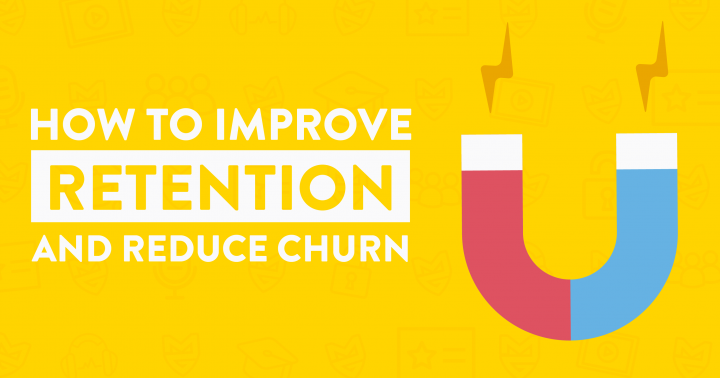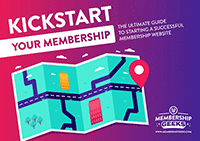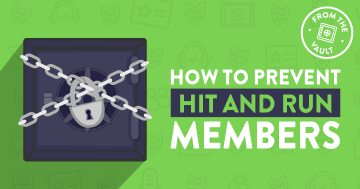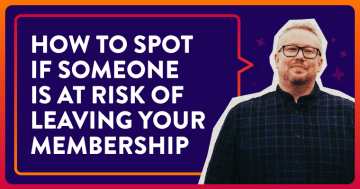Churn is perhaps THE key measure of membership site performance.
It’s a KPI that every membership site owner should be tracking…
But the majority of membership site plugins and programs don’t actually track this for you.
As a result, many membership site owners don’t realise this is something they should be tracking… Because they aren’t told about it.
If you don’t know that you don’t know, how are you ever going to fix it?
We want to change that, and help you get a handle on this essential metric for measuring your membership site’s success.
By the end of this post, you’ll understand what churn is, have an easy way to measure your churn rate, and know six key ways to improve your member retention!
What is churn?
Churn is the difference between how many members you have at the beginning of a month vs. how many you have at the end of it.
If you start a month with 100 members and end it with 90, losing 10 members, you have a churn rate of 10%.
So, the formula you need to use to calculate your churn rate is:
y/x=z
x = total number of members at the start of the month
y = total number of those members left at the end of the month
z = your churn rate
Member churn is effectively the way to measure your member turnover.
Sometimes people include new members and trials in their calculations… But for simplicity’s sake, we only look at the roster of fully signed up members at the start of each month and track where they are at the end of the month.
The way we measure churn is purely about retention, not sales or trials.
What is a good churn rate for membership sites?
A churn rate of 5% or under is the holy grail for online memberships.
5-10% is more common but certainly has room for improvement.
And a churn rate of 10% or more is a big red flag. Use this as a sign that you need to hone in on what’s going wrong, make changes, and ultimately lower your churn rate.
Now, let’s be clear about something: Churn is inevitable.
People are going to leave your site at some point. It’s part and parcel of running a subscription-based membership site.
Some membership models are even built on a high churn rate. For example, a membership that has one high-value, months-long course with the option of joining a community at the end of it.
If the value of your membership is frontloaded in this way, you can expect a high churn rate… You’re not really going to put too much emphasis on reducing that figure.
And, like any statistic, churn rate can’t be viewed in isolation.
If you have a churn rate of 5% but aren’t attracting any new members… That is a much bigger problem than if you have a healthy flow of new members.
If you lose 5% of your members each month and don’t recruit any new members, you’ll barely last a year.
6 ways to improve member retention
Now that we’re clear on what churn is, how to calculate your churn rate, and what you should be aiming for…
Let’s dive into ways you can reduce your churn rate and keep more members for longer.
1) Have a solid member onboarding sequence
Every membership site needs a good onboarding sequence. Your onboarding sequence is the steps and processes that you take new members through after they first join your membership.
This includes everything from what they see after they process their payment, the emails they receive, video tours, step-by-step guidance, and the ways you get them started with your content.
A well-thought-out onboarding sequence will squash any issues that could lead to you losing members in those vital early days.
Members might be leaving due to technical problems with your site, navigation issues, struggling to find the main feature that persuaded them to buy, or any other simple ‘starting point’ problems.
This comes down to making it as easy as possible for your members to use your site successfully from the get-go. If you can do this, you reduce your chances of losing members for avoidable reasons.
2) Be accessible to your members
Being visible, accessible, and helpful in terms of being able to solve people’s problems is essential – especially if people are leaving your site because of technical problems, as mentioned above.
If a new member can’t make your site work as they want and they can’t find a way to contact you (e.g. support email, contact form, feedback form, reporting function), you can’t be surprised if they choose to leave.
Making people work hard just to contact you is a bad look and most people are not going to make that effort.
What they will make the effort to do is cancel and probably ask for their money back!
If you’re accessible, with several obvious ways for members to contact you, you prevent these sticking points with technical support or usability questions.
Being accessible means you can nip problems in the bud early.
The couple of minutes you take responding to a support email could be the difference between someone cancelling in their first week vs. sticking around and getting value for years and years.
3) Frame your offering and pre-qualify your leads
Your promotional activity and sales pages should be accurate and reflective of the type of people you want to attract into your membership.
If people need to have certain competencies, skills, or knowledge to get value from your membership, then make sure it’s apparent at every step of the signup process.
This means making sure people know who and what your membership is for. If you scroll to the bottom of our Membership Academy homepage, you’ll see we address this as directly as possible!
Take the time to pitch your membership at the right level, so your potential members know what to expect and to ensure you are attracting the right people.
Because the wrong people are the ones who join and then run terrified by your membership’s complexity (or simplicity) as soon as they’re in.
4) Don’t overhype or mis-sell your membership
With membership sites, the transaction really begins when somebody joins your site. Don’t make the mistake of promising the universe and only delivering a planet!
Memberships don’t make their money from a single sale, the recurring revenue model means that your membership will only survive if people stick around for long enough.
And guess what?
People will only continue to pay you if you are delivering value to them!

Whatever you promise your members, you have to deliver.
Whether it’s courses, features, or even your availability to your members, you need to make sure your members get what they signed up for, otherwise, members are going to feel like they’re being ripped off.
Now that is a sure-fire way to have high churn.
5) Keep creating engaging content
Almost all of your members are signed up for your content, not for you! As we mentioned above, memberships work on a recurring revenue model. If members don’t get recurring value, you won’t get recurring revenue.
Create content with your members in mind – all of your training, courses, podcast episodes, whatevers, should all be focused on furthering the goals and results your members are hoping to achieve.
Not just that, though. Put extra time, thought, and effort into how you can make this content fun to digest.
You’re trying to make being a part of your community a worthwhile experience, beyond just being a source of educational content.
Members who aren’t engaged, who see your membership site as an afterthought, a ‘should do’, or a passing phase, are not going to be good members in the long run.
Luckily, you have the power to change that – you just have to make sure your content hits the right notes.
6) Provide alternatives to cancelling
If somebody does want to leave your membership, it’s potentially a lifesaver if you have can provide them with other options that are less drastic. Even better if you can pre-empt and prevent members from cancelling!
Not everybody who cancels their membership does so because they’ve consumed everything you’ve got on offer or because they’re unhappy with what you’re doing. A lot of the time, people cancel because their circumstances have changed.
It could be because they need to take some time to hone a particular skill before continuing. It could be as simple as money being a little tighter for the next few months.
These people might not want to leave, but feel like they have to.
If you give them a binary choice (stay or go), they’re only ever going to leave. If you provide other options that mean you still retain that member (or at least keep them more active than being a lapsed member), that puts you in a far better position to continue that relationship.
The two most obvious options are:
- allow members to pause their membership (losing their access but staying in your system, with dedicated content that keeps them engaged)
- have a ‘downsell’ (a skeleton version of your membership – for example, just your course library, with no live training or feedback sessions, for half price)
These aren’t cure-alls, but every member who chooses one of these options means income saved and churn reduced.
Conclusion
So, now you’re an expert on member churn, what steps will you be taking to improve your retention?
Those six suggestions again, if you need them, are:
- Have a great onboarding system
- Be accessible to your members
- Preframe and prequalify your membership
- Avoid overhyping or mis-selling
- Create engaging content
- Provide alternatives to cancelling
These are tried and tested, time and time again in our membership and the memberships that our members own! (That’s a tongue twister!)
We hope you find these helpful and that you’re able to make a dent in your churn rate as a result. If you’re after more advice on how to oil the wheels of your membership, why not join us in the Membership Academy or our free Facebook Membership Mastermind?





